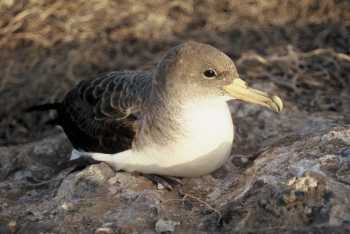Sandra Hervías (Faculty of Veterinary, University of Murcia, Animal Health Department, Spain) and colleagues publishing in the Journal of Zoology have looked at the diets of both feral and domestic cats Felis catus on Corvo Island in the Portuguese Azores Archipelago.
Cat predation on ACAP-candidate Cory’s Shearwater Calonectris borealis occurred mainly during the chick-rearing stage. The authors consider that a “potential management option is to restrict cat ownership in human settlements that are too close to vulnerable native wildlife congregations such as seabird colonies.”
The paper’s abstract follows:
“Populations of feral (not owned by humans) and domestic cats Felis catus coexist in most inhabited islands, and they have similar impacts on native species. Feral cats are generally believed to vary their diet according to prey availability; however, no previous studies of diet have tested this hypothesis on insular ecosystems with a limited range of available prey. Because domestic cats kill prey independently of hunger, the spatial extent of their impact on wildlife will be influenced by home-range size. In this study, we combined dietary information with cat movements to assess the impacts of feral and domestic cats on island biodiversity. We quantified the diet of cats from scat samples collected across one year and tested whether diet varies by season. The abundance of main prey categories was also estimated to document seasonal variation in prey availability for cats. Finally, we tracked domestic cats by global positioning system units in all four seasons to examine whether home-range patterns varied seasonally. The diet of cats constituted three prey groups (rodents, birds and invertebrates), and the seasonal variation in consumption of each taxon matched the seasonal variation in prey availability, thus supporting the generalist behaviour of cats on oceanic islands. Roaming behaviour varied among individuals and across seasons, but could not be explained by availability of prey. Unconfined cats had larger home-ranges than confined cats, but most domestic cats strayed <1 km from home. Thus, confinement of domestic cats might reduce the spatial extent of cat impact on native prey populations on oceanic islands.”

Cory's Shearwater, photographed by Paul Catry
Click here to read of a related paper by Sandra Hervías.
With thanks to Barry Baker for information.
Reference:
Hervías, S. Oppel, S., Medina, F.M., Pipa, T., Díez, A., Ramos, J.A., Ruiz de Ybáñez, R. & Nogales, M. 2013. Assessing the impact of introduced cats on island biodiversity by combining dietary and movement analysis. Journal of Zoology DOI: 10.1111/jzo.12082.
John Cooper, ACAP Information Officer, 18 November 2013

 English
English  Français
Français  Español
Español